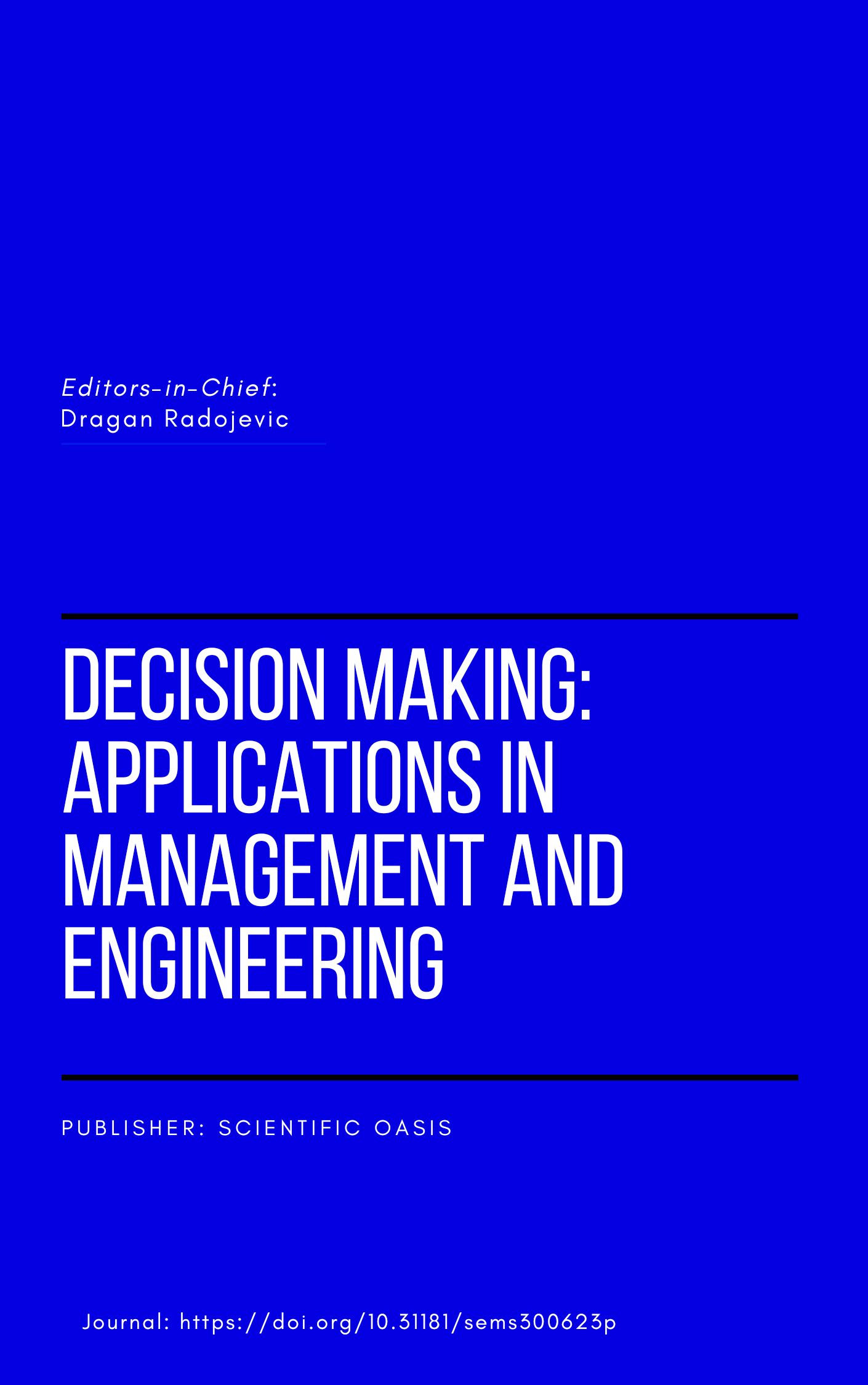Risks in Distribution Outsourcing: An Analytical Approach to Mitigation
DOI:
https://doi.org/10.31181/dmame7220241396Keywords:
Risks, Outsourcing, Distribution, LogisticsAbstract
Many organisations whose primary operations do not involve logistics typically face two strategic choices regarding the management of their logistics activities. The first involves managing logistics internally, referred to as in-house logistics, while the second entails delegating these functions to specialised external providers, thereby allowing the organisation to concentrate on its core competencies. Due to the consider-able benefits associated with outsourcing, numerous companies opt for this approach. However, outsourcing has notable implications for key supply chain functions, particularly in relation to cost efficiency and operational flexibility. In light of these considerations, the present study aims not only to explore the risks linked to logistics outsourcing but also to assess them quantitatively. To this end, the research identifies and evaluates 15 distinct risks. The findings reveal that three specific risks—vulnerability in data protection, the large-scale departure of skilled personnel, and inadequate training of contracted staff—are categorised as high. Corresponding mitigation strategies have been recommended to address these high-priority risks.
Downloads
References
[1] Zhu, W., Ng, S. C., Wang, Z., & Zhao, X. (2017). The role of outsourcing management process in improving the effectiveness of logistics outsourcing. International Journal of Production Economics, 188, 29-40. https://doi.org/10.1016/j.ijpe.2017.03.004
[2] Kavčič, K., Gošnik, D., Beker, I., & Suklan, J. (2015). How does logistics outsourcing influence organisation performance? International Journal of Industrial Engineering and Management, 6(3), 101. https://ijiemjournal.uns.ac.rs/images/journal/volume6/ijiem_vol6_no3_2.pdf
[3] Ali, A., Cao, M., Allen, J., Liu, Q., Ling, Y., & Cheng, L. (2023). Investigation of the drivers of logistics outsourcing in the United Kingdom's pharmaceutical manufacturing industry. Multimodal Transportation, 2(1), 100064. https://doi.org/10.1016/j.multra.2022.100064
[4] Švadlenka, L., Bošković, S., Jovčić, S., Simic, V., Kumar, S., & Zanne, M. (2023). Third-party logistics provider selection for sustainable last-mile delivery: A case study of E-shop in Belgrade. Journal of Urban Development and Management, 2(1), 1-13. https://doi.org/10.56578/judm020101
[5] Ismail, B., El Enin, M. A., Osama, M., Abdelhaleem, M., Geris, M., Kamel, M., Kassem, S., & Fahim, I. S. (2021). A heterogeneous vehicle routing problem with soft time windows for 3PL company’s deliveries: A case study. Journal Européen des Systèmes Automatisés, 54(6), 909-914. https://doi.org/10.18280/jesa.540614
[6] Andrejic, M., & Pajic, V. (2025). Integrated BWM–QFD–MARCOS framework for strategic decision-making in cold chain logistics. Journal of Operational and Strategic Analytics, 3(1), 23-33. https://doi.org/10.56578/josa030103
[7] Modarress, B., Ansari, A., & Lockwood, D. (2010). Outsourcing logistics to third-party providers: practitioners perspectives. International Journal of Logistics Systems and Management, 6(1), 23-38. https://doi.org/10.1504/IJLSM.2010.029719
[8] Giri, B., & Sarker, B. R. (2017). Improving performance by coordinating a supply chain with third party logistics outsourcing under production disruption. Computers & Industrial Engineering, 103, 168-177. https://doi.org/10.1016/j.cie.2016.11.022
[9] Huang, M., Tu, J., Chao, X., & Jin, D. (2019). Quality risk in logistics outsourcing: A fourth party logistics perspective. European Journal of Operational Research, 276(3), 855-879. https://doi.org/10.1016/j.ejor.2019.01.049
[10] König, A., & Spinler, S. (2016). The effect of logistics outsourcing on the supply chain vulnerability of shippers: Development of a conceptual risk management framework. The International Journal of Logistics Management, 27(1), 122-141. https://doi.org/10.1108/IJLM-03-2014-0043
[11] Premkumar, P., Gopinath, S., & Mateen, A. (2021). Trends in third party logistics–the past, the present & the future. International Journal of Logistics Research and Applications, 24(6), 551-580. https://doi.org/10.1080/13675567.2020.1782863
[12] Kalinzi, C. (2016). Outsourcing (Logistics) Services and Supply Chain Efficiency-A Critical Review of Outsourcing Function in Mukwano Group of Companies. Journal of Outsourcing & Organizational Information Management, 2016.937323. http://doi.org/10.5171/2016.937323
[13] Njoroge, A. W. (2013). Challenges Of Import Logistics Outsourcing By Manufacturing Firms In Nairobi University of Nairobi]. http://erepository.uonbi.ac.ke:8080/xmlui/handle/123456789/58535
[14] Mageto, J. (2022). Current and future trends of information technology and sustainability in logistics outsourcing. Sustainability, 14(13), 7641. https://doi.org/10.3390/su14137641
[15] Akhtar, M. (2023). Logistics services outsourcing decision making: a literature review and research agenda. International Journal of Production Management and Engineering, 11(1), 73-88. https://doi.org/10.4995/ijpme.2023.18441
[16] Afum, E., Agyabeng-Mensah, Y., Acquah, I. S. K., Baah, C., Dacosta, E., Owusu, C. S., & Amponsah Owusu, J. (2021). Examining the links between logistics outsourcing, company competitiveness and selected performances: the evidence from an emerging country. The International Journal of Logistics Management, 32(3), 1068-1090. https://doi.org/10.1108/IJLM-05-2020-0205
[17] Rintala, O., Solakivi, T., Laari, S., Töyli, J., & Ojala, L. (2021). Drivers of logistics outsourcing: examining transaction costs, core competences and planned behavior. International Journal of Physical Distribution & Logistics Management, 51(3), 259-280. https://doi.org/10.1108/IJPDLM-08-2019-0244
[18] El Mokrini, A., & Aouam, T. (2022). A decision-support tool for policy makers in healthcare supply chains to balance between perceived risk in logistics outsourcing and cost-efficiency. Expert Systems with Applications, 201, 116999. https://doi.org/10.1016/j.eswa.2022.116999
[19] Korucuk, S., Aytekin, A., & Karamaşa, Ç. (2022). An analysis for outsourcing based risks and problems in logistics enterprises. Journal of process management and new technologies, 10(3-4), 106-120. https://doi.org/10.5937/jpmnt10-41224
[20] Andrejić, M., & Pajić, V. (2024). Strategies for effective logistics outsourcing: A case study in the Serbian market. Journal of Organizations, Technology and Entrepreneurship, 2(1), 14-26. https://doi.org/10.56578/jote010202
[21] Doratiotto, K., Vidal Vieira, J. G., da Silva, L. E., & Fávero, L. P. (2023). Evaluating logistics outsourcing: a survey conducted with Brazilian industries. Benchmarking: an international journal, 30(3), 788-810. https://doi.org/10.1108/BIJ-06-2021-0341
[22] Khan, S. A., Alkhatib, S., Ammar, Z., Moktadir, M. A., & Kumar, A. (2022). Benchmarking the outsourcing factors of third-party logistics services selection: analysing influential strength and building a sustainable decision model. Benchmarking: an international journal, 29(6), 1797-1825. https://doi.org/10.1108/BIJ-03-2020-0121
[23] Blom, T., & Niemann, W. (2022). Managing reputational risk during supply chain disruption recovery: A triadic logistics outsourcing perspective. Journal of Transport and Supply Chain Management, 16, 13. https://doi.org/10.4102/jtscm.v16i0.623
[24] El Mokrini, A., Dafaoui, E., Berrado, A., & El Mhamedi, A. (2016). An approach to risk assessment for outsourcing logistics: Case of pharmaceutical industry. IFAC-PapersOnLine, 49(12), 1239-1244. https://doi.org/10.1016/j.ifacol.2016.07.681
[25] Regan, A., & Wang, C. (2003). Reducing risks in logistics outsourcing. https://escholarship.org/uc/item/47v6f9fx
[26] Popîrlan, C.-I., & Triculescu, D.-L. (2024). Developing a Mobile Application for Project Bidding and Service Matching. Journal of Research, 3. https://www.ceeol.com/search/article-detail?id=1295323
Downloads
Published
How to Cite
Issue
Section
License
Copyright (c) 2025 Decision Making: Applications in Management and Engineering

This work is licensed under a Creative Commons Attribution 4.0 International License.












